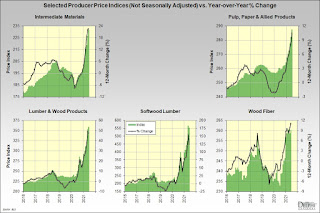The Consumer Price Index for All Urban Consumers (CPI-U) increased 0.9% in June (+0.5% expected) after rising 0.6% in May. This was the largest one-month change since June 2008 when the index rose 1.0%. The index for used cars and trucks continued to rise sharply, increasing 10.5% in June. This increase accounted for more than one-third of the seasonally adjusted all-items increase. The food index increased 0.8% in June, a larger increase than the 0.4% increase reported for May. The energy index increased 1.5% in June, with the gasoline index rising 2.5% over the month.
The
index for all items less food and energy rose 0.9% in June after increasing 0.7%
in May. Many of the same indexes continued to increase, including used cars and
trucks, new vehicles, airline fares, and apparel. The index for medical care
and the index for household furnishings and operations were among the few major
component indexes which decreased in June.
The
all-items index rose 5.4% for the 12 months ending June -- the largest 12-month
increase since a 5.4% increase for the period ending August 2008; the CPI has
been trending up every month since January, when the 12-month change was 1.4%.
The index for all items less food and energy rose 4.5% over the last 12-months,
the largest 12-month increase since the period ending November 1991. The energy
index rose 24.5% over the last 12-months, and the food index increased 2.4%.
The
Producer Price Index for final demand increased 1.0% in June (+0.6% expected).
Final demand prices rose 0.8% in May and 0.6% in April. Nearly 60% of the June
advance in the final demand index can be traced to a 0.8% increase in prices
for final demand services. The index for final demand goods moved up 1.2%.
On a year-over-year basis, the final demand index moved up 7.3% for the 12 months
ended in June, the largest advance since 12-month data were first calculated in
November 2010. Prices for final demand less foods, energy, and trade services
rose 0.5% in June following an increase of 0.7% in May. For the 12 months ended
in June, the index for final demand less foods, energy, and trade services
moved up 5.5%, the largest advance since 12-month data were first calculated in
August 2014.
Final Demand
Final
demand services: Prices for final demand services rose 0.8% in June, the sixth
consecutive advance. Seventy percent of the broad-based increase in June is
attributable to margins for final demand trade services, which moved up 2.1%.
(Trade indexes measure changes in margins received by wholesalers and
retailers.) The indexes for final demand services less trade, transportation,
and warehousing and for final demand transportation and warehousing services
rose 0.3% and 0.9%, respectively.
Product
detail: Twenty percent of the June increase in the index for final demand
services can be traced to margins for automobiles and automobile parts
retailing, which rose 10.5%. The indexes for machinery and vehicle wholesaling;
hardware, building materials, and supplies retailing; guestroom rental;
professional and commercial equipment wholesaling; and transportation of
passengers (partial) also moved higher. Conversely, margins for apparel
wholesaling fell 6.0%. The indexes for machinery and equipment parts and
supplies wholesaling and for gaming receipts (partial) also declined.
Final
demand goods: Prices for final demand goods increased 1.2% in June after rising
1.5% in May. Nearly 60% of the broad-based advance in June can be traced to the
index for final demand goods less foods and energy, which moved up 1.0%. Prices
for final demand energy and for final demand foods rose 2.1% and 0.8%,
respectively.
Product detail: Within the index for final demand goods in June, prices for industrial chemicals rose 4.5%. Prices for gasoline, meats, electric power, processed poultry, and motor vehicles also moved higher. In contrast, the index for oilseeds fell 11.7%. Prices for diesel fuel and for distilled and bottled liquor (excluding brandy) also declined.
With the exception of softwood lumber, the not-seasonally adjusted price indexes we track all rose on both MoM and YoY bases.
The foregoing comments represent the
general economic views and analysis of







No comments:
Post a Comment
Note: Only a member of this blog may post a comment.